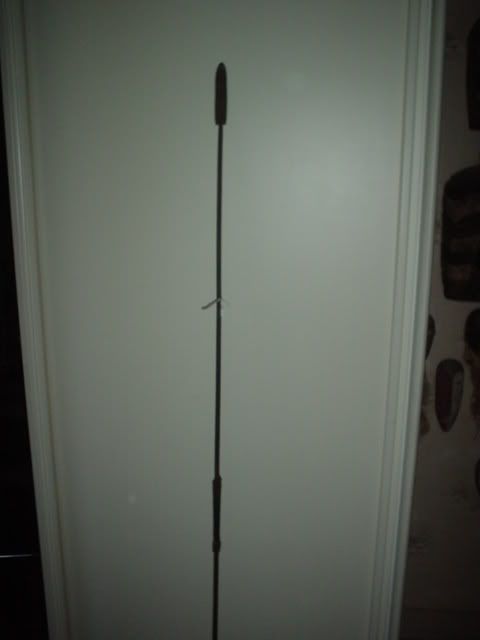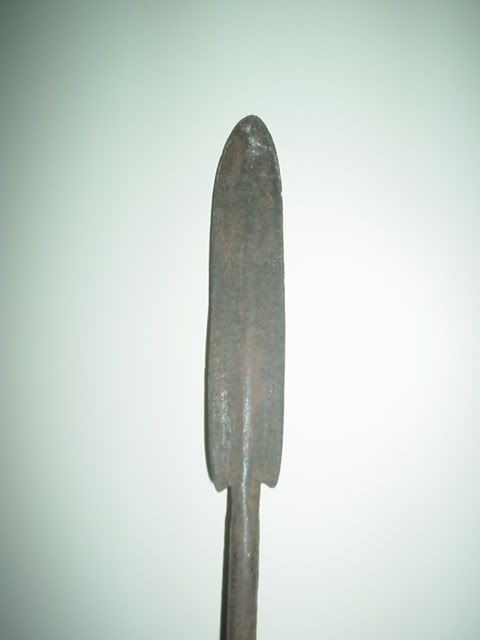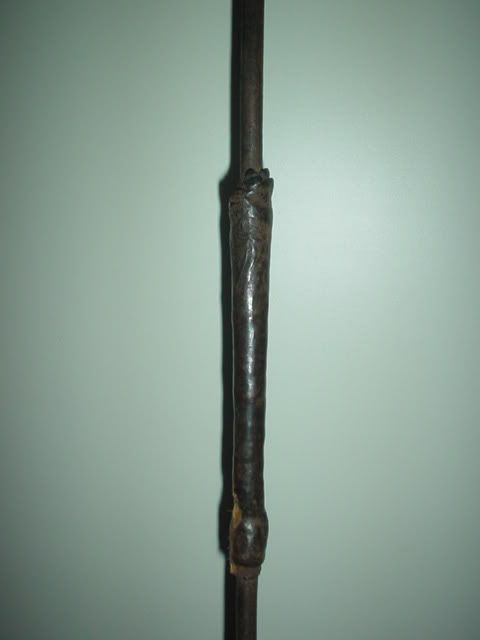
 |
|
|
#1 |
|
Member
Join Date: Jan 2006
Location: Kent
Posts: 2,658
|
Hi everyone,
I have recently acquired this interesting initiation spear, a ritualistic piece from an initiation society of the Masai people, associated with rite-of-passage rituals for boys Apparently, this item was presented to a Victorian Missionary and had been kept in the family since then .The overall condition is very good, and definately has an air of age. The workmanship is excellent, the iron blade is thin with a central rib, hide and animal hair (Lion mane ?) adorn the handle area , the spear ends with a forged iron spike. The spear is approx 45,5'' / 116cms long, the blade is 6.5'' / 16.5cm. I would appreciate any input or information, thankyou [IMG]http://[/IMG] |
|
|

|
|
|
#2 |
|
Member
Join Date: Dec 2004
Location: What is still UK
Posts: 5,925
|
I almost bid on this. I think it is a very nice thing to have , It is not Victorian. I also have my doubts it is Massai, personally I think it comes from further south like northen South Africa , Lesotho or there abouts and nothing to do with boys. The skin and hair is bovine. I shall try and find some pictures. Great story, it is a good thing and you got it at a very good price. Tim
|
|
|

|
|
|
#3 |
|
Member
Join Date: Feb 2006
Location: France
Posts: 473
|
I'm not sure it is Masai, they have 2 kinds of spears you can see them on my website :http://lulef.free.fr/html/masai.html
Tutsi in Rwanda have spears like yours. Nice acquisition. Luc |
|
|

|
|
|
#4 |
|
Member
Join Date: Jan 2006
Posts: 178
|
my massai blade
galvano |
|
|

|
|
|
#5 |
|
Member
Join Date: Dec 2004
Location: What is still UK
Posts: 5,925
|
I think Luc might have put his finger on it. Here is a picture of a Angoni warrior, a branch of South African {Zulu?} people that were raiding neighboring people around lake Tanganyika and towards Nyassaland. Note the similar all steel spear. Tim

|
|
|

|
|
|
#6 |
|
Member
Join Date: Jan 2006
Location: Kent
Posts: 2,658
|
Thankyou for all your replies. I wasn't convinced that the spear was Masai, due to the spear blade's shape. I had tried to research the Masai initiation ceremonies but could find no reference to boys using such ceremonial spears.
Unfortunately, it seems nearly 'every' spear I have seen is often falsely described as either Zulu or Masai, to enhance the price. However, this spear is well crafted, old and of interest. I would like to 'nail' the origin of the spear. Thankyou Tim, again, for your Knowledge of African weapons, could you suggest any books on the subject? (ie knives, swords and spears). |
|
|

|
|
|
#7 | |
|
Member
Join Date: Oct 2005
Posts: 58
|
Quote:
|
|
|
|

|
|
|
#8 |
|
(deceased)
Join Date: Dec 2004
Location: OKLAHOMA, USA
Posts: 3,138
|
THE YOUNG MASAI DO DRESS IN A SPECIAL GARB AND OFTEN COVER THEMSELVES IN ASH OR SOMETHING WHICH MAKES THEM APPEAR WHITISH. THE ONES I HAVE SEEN HAD STICK SPEARS AND SHIELDS. I HAVE ONE OF THE SHIELDS AND DID NOT SEE ANY GROWN MASAI WITH SHIELDS SO I SUSPECT THEY ONLY HAVE A CEREMONIAL FUNCTION IN THEIR SOCIETY THESE DAYS. I DIDN'T SEE A BOW PERHAPS THEY ARE ONLY USED AND CARRIED AT CERTIAN TIMES AND PLACES. I'M JUST GUESSING AS I HAVE NEVER RESEARCHED THE MASAI, JUST READ A BIT HERE AND THERE AND HAVE SEEN THEM IN TANZINIA.
|
|
|

|
|
|
#9 |
|
Member
Join Date: Dec 2004
Location: Sint-Amandsberg (near Ghent, Belgium)
Posts: 830
|
Luc, according to the book 'African Arms and Armour' by Christopher Spring, there are more types of Maasai spear.
This is what he writes in his book : The graded system of Maasai society is reflected by the four distinct types of spear commonly used by them. The uncircumcised boys usually carry a javelin-like spear, esururu, made out of one piece of rounded iron, sometimes with a leather hand grip bound around the centre. The head is sometimes hammered into an oval shape but often left straight. The butt is usually of square section. A couple of years ago, I happened to stumble onto such a spear. Here are some pics :    This is not some kind of ceremonial item. It has a real good balance and is fairly heavy (all iron). I think it would do quite some damage when thrown at something or someone. The total length is approx 1m80 (72 inches) |
|
|

|
|
|
#10 |
|
Member
Join Date: Jan 2006
Location: Kent
Posts: 2,658
|
I have searched on the internet and discovered this picture and discription in a Anthropology Collections website.
AFRICAN ETHNOGRAPHIC COLLECTION Culture: MASAI(MASSAI), WAHUMBA? Locale: WAHUMBA? Country: KENYA Material: WOOD,METAL(IRON),LEATHER Dimensions: L:170.2 W:5.7 [in CM] Donor: SCHIFF Acquisition Year: 1898 Spear (1/5533) Notice the spearhead shape, the central rib, and the date of acquisition 1898, Perhaps around this time this design spearhead / spear were more common? |
|
|

|
|
|
#11 |
|
Member
Join Date: Dec 2004
Location: What is still UK
Posts: 5,925
|
Freddy what a nice spear rather like the Tuareg all metal spear.
Saying a people used just one or two types of spear is a trifle bombastic. This is often said about the Zulu. Spears vary in function and a spear blade unless very distinctive, is a rather mature design making attribution just on an ordinary shape without provenance or documented evidence a little tricky. A book reviewing pan African spear types would be a great publication also a Herculean task and most probably rather expensive. Picture Hutchinson & co London 1918. Okay the caption says Kikuyu but culturally not dissimilar to the Massai who I believe used the same initiation shields symbolising emergence. Just thought the picture was relevent to the thread. Tim 
Last edited by Tim Simmons; 3rd March 2006 at 08:39 PM. |
|
|

|
|
|
#12 | |
|
Member
Join Date: Jan 2006
Posts: 123
|
Quote:
|
|
|
|

|
|
|
#13 |
|
Member
Join Date: Jan 2006
Location: Kent
Posts: 2,658
|
This recently finished on eBay, similar to the spear that started this thread, but not as well made/forged. The seller stated it was described as 100% Zulu when bought from a reputable auction house
 http://cgi.ebay.co.uk/ws/eBayISAPI.d...0440&rd=1&rd=1 I think it was mis-described, has anyone any thoughts or comments? Regards David |
|
|

|
|
|
#14 |
|
Member
Join Date: Dec 2004
Location: What is still UK
Posts: 5,925
|
Again I think this is most likely Ngoni. I got this little Ngoni? Shona? dance spear recently. I think is very pretty. I think the owner did too, as it has been repaired. The halft is only 13mm diameter so it may have easily been broken in vigorous dance. The edges are not sharp. I have examined the repair with my jewellers loop and I am feeling happy to tell myself it is genuine native work with gum and wire. There was a label 1862 on it but that is a bit like believing what you read in the newspapers. I have cleaned the spear and the flash is on. Total length 80cm.
|
|
|

|
|
|
#15 |
|
Member
Join Date: Jan 2006
Location: Kent
Posts: 2,658
|
Hi Tim,
the binding (wire?) on your spear is very similar to the bindings found on a number of Zulu spears. |
|
|

|
|
|
#16 |
|
Member
Join Date: Dec 2004
Location: What is still UK
Posts: 5,925
|
Hi David,
This is a difficult area to be certain as the same weapons and technology is used by many people that live in the South East tip of African. I have always thought that the real good Zulu artifacts do not usually come with the brass wire decoration but that could just be one of those collector opinions. A good book to get is quite cheap and from amazon- Art of South East Africa. having said that I do have things that I believe are Zulu and they do not have brass wire on them. |
|
|

|
 |
|
|